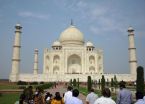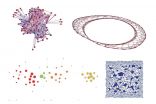(Press-News.org) The Taj Mahal's iconic marble dome and soaring minarets require regular cleaning to maintain their dazzling appearance, and scientists now know why. Researchers from the United States and India are pointing the finger at airborne carbon particles and dust for giving the gleaming white landmark a brownish cast.
Knowing the culprits in the discoloration is just the first step in cleaning up the Taj Mahal. Scientists now must determine where the particles are coming from to develop strategies for controlling them.
"Our team was able to show that the pollutants discoloring the Taj Mahal are particulate matter: carbon from burning biomass and refuse, fossil fuels, and dust - possibly from agriculture and road traffic," said Michael Bergin, a professor in the School of Earth and Atmospheric Sciences at the Georgia Institute of Technology. "We have also been able to show how these particles could be responsible for the brownish discoloration observed."
Supported by the Indo U.S. Science and Technology Forum, the U.S. Environmental Protection Agency, and the National Science Foundation, the research was reported online December 3, 2014, in the journal Environmental Science & Technology. In addition to Georgia Tech, researchers from the Indian Institute of Technology at Kanpur (IIT-K), Archaeological Survey of India (ASI), and the University of Wisconsin collaborated on the project.
Built in the 1600s by Mughal emperor Shah Jahan in memory of his third wife, Mumtaz Mahal, the structure is a mausoleum that includes a massive marble dome 115 feet high and minarets that reach 130 feet. Attracting millions of visitors each year, the Taj Mahal became a UNESCO World Heritage Site in 1983.
Beginning in the 1970s, observers noted a brownish cast to the white marble that makes up the structures. Today, routine cleaning, including the painstaking application and removal of a clay material, maintains the brightness of the marble. Air pollution had been suspected as the culprit responsible for the discoloration, but no systematic study had been done and the specific components of the air pollutants responsible for the discoloration and the mechanisms by which they discolor the surface had remained unknown.
To find out what was causing the color change, a team from four different institutions was assembled. In addition to Bergin, it included Sachchida Nand Tripathi and Tarun Gupta from the Indian Institute of Technology in Kanpur, India; K.S. Rana from the Archaeological Survey of India in Delhi; Martin M. Shafer, Ana M. Villalobos, and James J. Schauer from the University of Wisconsin's Environmental Chemistry and Technology Program, and J. Jai Devi and Michael Mckenzie from Georgia Tech.
The researchers used air sampling equipment to measure what was in the air in the Taj Mahal complex from November 2011 through June 2012. Filters from the air-sampling equipment were analyzed for both fine particulate matter (smaller than 2.5 microns in diameter) and total suspended particulate matter. The analysis was done by scientists in both India and the United States.
In addition, the researchers placed small samples of pristine marble onto the Taj Mahal at various locations near the main dome. After exposure to air pollutants over a two-month period, the samples were analyzed using an electron microscope to measure the size and the number of particles deposited on their surfaces as well as their elemental signatures. This information allowed the researchers to determine the likely composition of the particles.
The researchers found particles of dust, brown organic carbon and black carbon in the filters and on the marble samples, Bergin said. The carbon particles come from a variety of sources, including fuel combustion, cooking and brick-making, trash and refuse burning, and vehicle exhaust. The dust may come from local agricultural activities and vehicular traffic - or from distant sources.
To check their analysis, the researchers refined a model for showing how the surface reflectance of the building's marble should change with the application of brown and black carbon particles, along with dust. The predictions of the model matched what was being observed on the Taj Mahal.
"We fundamentally showed how these particles change the color of the surface," said Bergin, who is also associated with the School of Civil and Environmental Engineering at Georgia Tech. "We hope to share this model with others who could use it to determine how urban and natural environments are changing colors due to particulate pollution."
Now that researchers know what's discoloring the Taj Mahal, the next step will be to identify the sources of the particles and plan control strategies. The sources could be local - and the government has already taken steps to reduce vehicle and industrial emissions in the area - or the particles could be coming from longer distances away from the region.
While the research focused only on the Taj Mahal itself, reducing particulate matter in the Agra region around the landmark would have additional benefits.
"Some of these particles are really bad for human health, so cleaning up the Taj Mahal could have a huge health benefit for people in the entire region," said Bergin. "The health of humans and the health of the Taj Mahal are intertwined."
INFORMATION:
This research was supported by the Indo U.S. Science and Technology Forum (IUSSTF), the U.S. Environmental Protection Agency (EPA) under grant RD83479901, and by the National Science Foundation (NSF) under PIRE grant 1243535. An opinions expressed are those of the authors and may not necessarily represent the official views of the IUSSTF, EPA or NSF.
CITATION: Mike H. Bergin, et al., "The Discoloration of the Taj Mahal due to Particulate Carbon and Dust Deposition," (Environmental Science & Technology, 2014). http://pubs.acs.org/doi/pdf/10.1021/es504005q
New York, NY, December 9, 2014 - Fourteen years after the attack on the World Trade Center (WTC), a case study in the current issue of Annals of Global Health identifies several elements that have had a critical impact on the evolution of the WTC response and, directly or indirectly, on the health of the WTC-exposed population. The case study also recounts and assesses post-disaster monitoring efforts, recent scientific findings from the World Trade Center Health Program (WTCHP), and explores the implications of these experiences for ongoing and future environmental disaster ...
The global spread of Ebola is due to the complex interactions between individuals, societies, and transportation and trade networks. Understanding and building appropriate statistical and mathematical models of these interactions is vital to responding to the challenges of living in a networked world. There are, of course, many other examples of complex networks -- from national power grids and airline networks to social networks, neuronal networks and protein-protein interactions.
In a new study published in the Beijing-headquartered journal National Science Review, ...
This news release is available in Japanese.
New research published in the Proceedings of The Royal Society A by members of the Mathematical Soft Matter Unit at the Okinawa Institute of Science and Technology Graduate University examines the energies at work in a closed flexible loop spanned by a soap film. While the underlying experiments are simple enough to be replicated in a kitchen sink, the research generates potentially important questions and changes how we think about different disciplines from material science to vertebrate morphogenesis. Aisa Biria and Professor ...
UNIVERSITY OF CALIFORNIA, BERKELEY'S HAAS SCHOOL OF BUSINESS -Too many vehicles on the highway inevitably slow down traffic. On the Internet information highway, consumers value high-speed Internet service, but there is little reason to think broadband traffic congestion will improve if the Federal Communications Commission abandons net neutrality, according to economic research.
In their paper, "The Economics of Network Neutrality," Ben Hermalin, Haas Economics Analysis and Policy Group, and Nicholas Economides, Berkeley-Haas visiting professor from NYU'S Stern School ...
Scientists at the University of Strathclyde and City University of New York have created methods that dramatically simplify the discovery of biological gels for food, cosmetics and biomedicine, as published in the journal Nature Chemistry.
Strathclyde's Dr Tell Tuttle and Professor Rein Ulijn, the director of nanoscience at City University New York's new advanced research centre who also holds a position at Strathclyde, believe their team's breakthrough dramatically simplifies discovery of functional gels that can be used in a wide range of applications.
Until now, ...
The drug daclatasvir (trade name Daklinza) has been available since August 2014 for the treatment of adults with chronic hepatitis C (CHC) infection. The German Institute for Quality and Efficiency in Health Care (IQWiG) examined in a dossier assessment whether this new drug offers an added benefit over the appropriate comparator therapy.
The drug manufacturer presented data for patients without cirrhosis of the liver who are infected with hepatitis C virus (HCV) genotype 1, and for patients with HCV genotype 4. However, these data are unsuitable in various aspects to ...
Pioneering new research by the University of Exeter could revolutionise global diagnostic procedures for one of the most common forms of epilepsy.
Scientists from Exeter have investigated using mathematical modelling to assess susceptibility to idiopathic generalised epilepsy (IGE) by analysing electrical activity of the brain while the patient is in a resting state.
Current diagnosis practices typically observe electrical activities associated with seizures in a clinical environment.
The ground-breaking research has revealed differences in the way that distant regions ...
"A tree must be bent while it is young," as one saying about learning a foreign language goes. In other words, the earlier you start learning a foreign language systematically, the better the language level will be in the long run. The second widely held view is that you need to be solid in your first language (L1) in order to develop good literacy skills in the foreign language. Linguist Simone Pfenninger from the University of Zurich has been examining these two myths in her five-year study involving Swiss high-school children in order to identify the optimal starting ...
Reston, Va. (December 9, 2014) - Cancer therapy can be much more effective using a new way to customize nuclear medicine treatment, researchers say in the December 2014 issue of The Journal of Nuclear Medicine. The process could also be useful for other diseases that could benefit from targeted radiation.
Targeted therapy with radiopharmaceuticals--radioactive compounds used in nuclear medicine for diagnosis or treatment--has great potential for the treatment of cancer, especially for cancer cells that have migrated from primary tumors to lymph nodes and secondary organs ...
London, United Kingdom, December 9, 2014 - As the Ebola Virus Diseases (EVD) epidemic continues to rage in West Africa, infectious diseases experts call attention to the striking lack of treatment guidelines. With over 16,000 total cases and more than 500 new infections reported per week, and probable underreporting of both cases and fatalities, the medical community still does not have specific approved treatment in place for Ebola, according to an editorial published in the International Journal of Infectious Diseases.
Not only are treatment guidelines lacking, but ...





